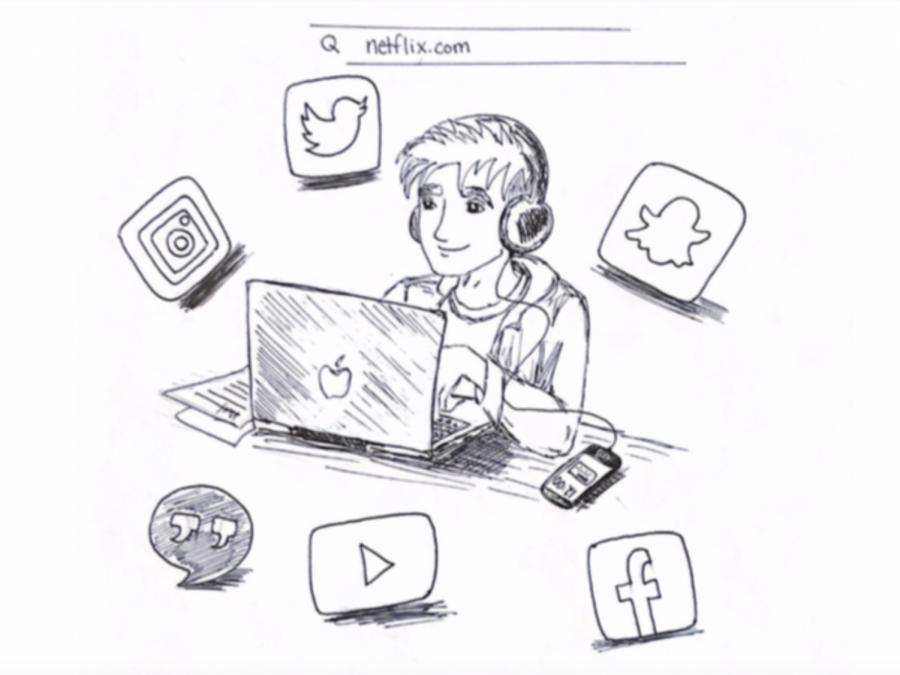Online learning brings new challenges and opportunities
Rhea Braganza
With productivity behaviors changing, remote learning has posed new problems for educators and students alike.
May 3, 2020
Amidst the coronavirus outbreak, schools across the country have switched from face-to-face instruction to online learning, which can affect students’ mental health and productivity in various ways.
To meet social distancing expectations and health guidelines, schools closed their doors rapidly nationwide. In California alone, more than 1.5 million students have been affected by the change.
To keep students engaged remotely, districts such as the San Francisco, Piedmont and San Ramon Valley Unified School Districts continue to actively explore online curriculum for their students. Understandably, the sudden shift to a completely new platform of instruction comes with consequences. Teachers have had to scramble to adapt lesson plans and curriculum to an unfamiliar environment.
Ms. Faith Dionida, a high school English teacher at Dougherty Valley, says, “It’s a lot different trying to give [students] instruction and materials online compared to face-to-face, [but] we’re still trying to teach the same set of skills we want you to learn for next year.”
A major concern is that students will be spending too much time online. Inevitably, substituting a seven-hour school day with an entirely digital platform will require a large part of the day to be spent on electronics. According to a study by Duke University, adolescents who spend excessive amounts of time online can develop difficulties concentrating (a symptom of ADHD), internet addiction and behavioral problems.
Not only this, but students are expected to multitask much more when completing online assignments. In fact, a study done by Andrew Lepp at Kent State University found that out of 452 undergraduates at public universities, “students enrolled online reported higher rates of texting, emailing, watching videos, [and] playing video games.”
Unfortunately, multitasking is detrimental because the brain does not absorb information accurately. A study by the International Journal of Human-Computer Studies found that students who multitask have the same intelligence quotient as students who pull all-nighters. And with multitasking, students are likely to scroll between social media apps even more than they already do, which Dr. Andrew Weil finds can cause anxiety and loneliness.
Another concern with digital teaching is that students lack social interaction. Since peers are constantly around each other in a classroom environment, it is easier for conversations to occur frequently, but with a screen now separating classmates, it takes more of an effort to stay connected. According to The Robert Johnson Wood Foundation, interaction with peers is incredibly important for students. The foundation suggests that peer relationships are key to providing emotional connections, support during difficult times and the ability to make healthy relationships with those outside of your family.
The American Psychological Association suggests that isolation from peers can lead to effects on physical and mental health, such as poor sleep quality and depression.
“My mental health has decreased because I don’t get to see my friends on a daily basis. I feel really isolated,” freshman Navya Kancharla says.
Despite these worries, there are some possible strengths to online learning that face-to-face instruction does not provide. According to the University of Illinois-Springfield, online learning allows students to “self-pace,” which can be more convenient than the strict schedule that school lectures and homework require. It is also more effective for students who need repetition or prefer to study the details more without the stress of having to keep up with their peers.
“I feel like I can go at a faster pace and I can follow my own review schedule. My productivity is also better because I have more time to do other things besides school work, and I am more motivated to do those activities, so I don’t sit around procrastinating,” junior Sanjita Pamidimukkala says.
However, some students still feel unmotivated and unproductive due to the lack of school-enforced scheduling. Sophomore Ariya Savla explains that the drawback to online learning is that she feels less “disciplined at home.”
Salva adds, “I feel that my productivity has declined. At school we have clear deadlines and consequences for not completing work, unlike online learning where it can become easy to procrastinate.”
Regardless of the debated impacts of online learning, it is here to stay — at least for the near future. A project by the Southern Poverty Law Center called Teaching Tolerance published suggestions for educators and students alike to maximize the learning experience while protecting mental health.
The center encourages students and teachers to establish a routine with their assignments, which will hopefully bring a sense of order and calm during these uncertain times. In addition to this, they also recommend teachers keep classrooms inclusive virtually by asking students to share one moment from their days and discussing how they feel. The project also lists mindfulness as another key trait to practice, which can be done through simple breathing exercises or taking small self-awareness assessments that can be found online.
Nevertheless, Dionida has hope for students.
“Every Monday morning, if you set yourself up and figure out when you can do the work, you guys will be set up for success,” she says.




